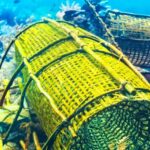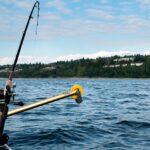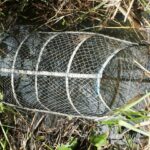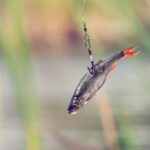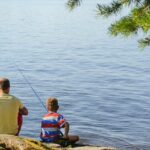Fishing can be far more complex than most people realize. A successful fishing excursion requires a good understanding of fishing techniques, where to fish, and how deep to fish to catch the fish that you are after. Lake fishing requires a good understanding of the depth and how to fish various depths for a successful catch.
The depth you should fish in a lake depends on the fish you want to catch. Larger fish tend to stay near the bottom, especially in deeper water, and smaller fish dwell near the surface or in shallow water. Base your fishing depth on your target fish, and you will have much better success.
The depth at which you fish can determine the fish you catch and your success on the day. However, the correct depth to fish at in a lake depends on many factors, including the weather, the season, and the fish you target.
How Deep Should You Fish In A Lake?
Lake fishing is fun and challenging. Lakes usually host a variety of fish species, and how you fish determines what you will catch. Lakes come in all shapes, sizes, and depths, and fishing every lake is different, so how do you know how deep to fish when fishing on a lake?
The reality is that the depth at which you fish is critical, but just because you get the depth wrong does not mean you will not catch anything. Different fish dwell at different depths, which is a factor you must consider when fishing.
Every angler knows that different bait items and lures work for different fish; the same is true for different depths. You will not catch a herbivorous fish with chicken livers, and you will not catch a bottom feeder on the surface. These truths are as important as each other.
This means it is important to understand the depths to fish at, especially when fishing in a lake, to ensure you catch the fish you are after.
There are several factors that determine the depth you should fish at in a lake, so let’s explore the various depths to fish at based on the most important factors.

Fish Deep In Winter
There is no set-in-stone rule for the depth at which you should fish, but there are some good practices to maximize your chances of fishing success when lake fishing, especially based on the season and the overall temperature.
Fish that dwell in lakes adjust their behavior according to the general temperature. This means that fish dwell at different general depths depending on the season.
When the weather gets cold, especially during the winter, fish are much more likely to dwell at lower depths. The deeper the water is, the more insulated it is from the cold air, and the better the fish can regulate their body temperature.
For this reason, when fishing in lakes, especially for game fish, it is better to fish deeper when the air temperature is low. This could be in winter, on particularly cold days, or when there is ice or snow on the water.
Fish tend to congregate in trenches or ditches on the waterbed when the air is very cold, so try to fish as deep as you can in lakes during the winter.
This is not the rule for all lakes, however, as some lakes are located in areas that never get cold. In these instances, the only fish that are at the bottom are bottom feeders.
Fish Shallow In Summer
The summer months or hot days are the opposite of fishing in winter when lake fishing. Fish tend to come closer to the surface of the water in the summer months, as the water is cooler due to convection cooling from the wind.
However, fish do not like to be in sunlight during the summer, so game fish are unlikely to be right at the surface unless there is an area of shade.
The summer also brings a bounty of insects and baitfish for larger fish to eat, drawing them closer to the surface where these food items dwell.
For this reason, during the summer months or on hot days, you are more likely to have a successful lake fishing outing by casting near the surface of the water and allowing your rig to sink just below the sunrays, if possible.
There are exceptions to this, such as when fishing for bottom-feeders, but this general rule works well for most game or medium-sized fish.
Shallow fishing depends on the depth of the lake. Some lakes are not deep at all, and the shallowest sections are near the shoreline. Look for shallow areas that have plenty of places to hide, cover vegetation, and plenty of food for the fish, and you will have the best luck at these depths in these locations.
Fish Shallow At Night
Fish tend to swim close to the surface at night, as there is no sunlight to disturb them. Sun rays can cause too much heat for fish, and the dappled light through the water can affect their vision as well, so they usually stay below depths where the light can pierce the water.
However, at night, this is not an issue, and the fish are far more likely to be in shallower waters in search of food.
Fish do not stop eating at night. They only eat less. This means that if you can find a good area dense with fish, it is best to fish closer to the surface or in shallow waters, as this is where the fish will look for food.
The only exception is very cold nights, where the fish are more likely to be in deeper water or at the bottom of the lake.
With that said, if you want to enjoy some night fishing on a lake, try not to fish too deep and keep to the shallows for best results.

Fish Shallow At Dawn And Dusk
Dawn and dusk are when fish are most active. The water is warm, but there is not too much sunlight to bother the fish, and there are plenty of insects and other food items around during these times of the day.
This increased activity means that fish are more likely to search for food in shallow water or near the water’s surface, and they are more likely to take risks to find food due to the higher level of competition.
All fishermen will tell you that fishing at dawn and dusk in lakes has yielded the best results. However, the depth that you fish at these times is still important.
Lake fishing is best done at dawn and dusk as possible, especially in lakes that are otherwise difficult to fish. The best technique for the best results during these optimum times of day for fishing is simply to use good bait and keep your rig shallow. This will yield the best results.
Fish Shallow On Cloudy Days
Cloudy days usually result in much less sunlight reaching the water, allowing fish to swim nearer to the surface and keep to shallow water more readily.
This means lake fishing on cloudy days should be done in the shallows or near the water’s surface.
If you want to catch any fish possible, simply fishing off the lake bank at a shallow depth is good on cloudy days.
If you seek game fish, travel a few feet from shore, and fish back toward the bank in shallow water, where the game fish hunt for baitfish and insects.
Shallow depths are usually best on days where there is little or no sunshine unless the day is very cold, in which case the fish are more likely to be at a deeper depth.
Rainy days also call for shallower depths, as the fish are drawn to the surface of the water by the rain, especially during the summer. Warm days with rain are a perfect day to fish near the surface of the water when lake fishing, as most fish will come to shallower depths during this type of weather.
Fish At Various Depths To Find Fish
Another thing to remember when lake fishing is that every lake is different. If you are used to fishing very deep in one lake and exploring a new lake, the waterbed is likely to be at a very different depth.
If you are fishing in an unfamiliar lake, especially when you do not know what fish are present in the lake, it is always best to fish at various depths to find the fish you seek.
Travel out into a good section of the lake and sink your line to the bottom of the lake. This will give you a good indication of the depth of the lake at that location.
Raise your bait or lure a little above the bottom, and fish at this depth for a while.
Slowly work your way up in-depth until you find the fish. Some fish may be at very low depths or at the bottom of the lake; some may be suspended just above it, while others may be suspended in the mid-water, and others may be close to the surface.
The depth that the fish are at depends on several factors, and if you do not know where they are, this is the best method to find them, especially when fishing in an unfamiliar lake.
Take your time with this process, as it can be tedious, but it is among the surest methods for determining fishing depth in a lake, especially when looking for a particular type of fish.
Fish Just Above The Bottom For Game Fish
When fishing in lakes for game fish, a tried and true method is to fish just above the bottom of the lake.
This is especially true for very deep lakes, or at least lakes that are deeper than around 20ft or so. Fish like trout, smallmouth bass, and others of the like are most likely to be suspended within a foot of the bottom of the lake, depending on the season.
In most seasons, the fish will be at this depth, but they may venture sallower during the summer to feed on baitfish that dwell in the shallows of the lake.
The largest of the fish species are likely to be deeper than the others, so if you are looking for a large trophy bottom-feeder or game fish, look for them in the lowest sections you can find that are still near to where baitfish might be, and set up your gear with good bait. This will likely work well when fishing lakes.
Fish Deep For Bottom Feeders
An obvious depth to fish at when fishing for bottom feeders is as deep as possible, as these fish are always at the bottom of the lake. It is very rare that bottom feeders venture to the surface. It does happen, but it is rare. This means that the best chance of catching a large bottom feeder lies at the bottom of the lake.
This requires specific tackle and gear, but if you have the gear for it, fish as deep as you can for bottom feeders. Look for areas of steep drop-offs where smaller fish may dwell and drop your line on the deep end of the drop-off.
Look for deep areas with vegetation above and look for areas that have baitfish. Cast as deep as you can in these areas until you reach the bottom, and fish these lake areas for bottom feeders such as catfish, carp, and even sturgeon if you can find them.

Fish Deep For Large Fish
If you seek the largest fish in the lake, it is best to fish as deep as your can, especially if the lake is not very deep itself. Large fish need a lot of food. This means they will be found where there is plenty to eat.
Small fish tend not to live too deep, which means that the largest fish tend to alternate between depths ins search of food.
The most likely place to find large fish is in deeper water, near the bottom. Your presence is likely to scare them deeper, and they will look for food at the lower depths while you are in the area.
For these reasons, if you are looking for big fish in a lake such as large carp or alligator gar, find an area with a lot of food for the fish, bait the fish well, and fish quite deep to find the most success.
Fish Shallow For Smaller Fish
If you seek smaller fish for a meal, for bait, or simply because you do not mind what you catch while lake fishing, the surest place to get a bite is in shallow water closer to the shore or near the surface of the water further out into the lake.
Smaller fish do not venture deeper into the water and tend to dwell in areas with more food, more shelter, and a better mix of water temperatures.
All fish but bottom feeders and large game fish tend to remain in areas of lakes where there is easy access to shallow and deeper water.
Look for drop-offs closer to the shore or structures underwater, such as rocks or fallen trees, and you will likely find fish such as trout, bass, and bullhead to catch at these depths.
This does not apply to all fish, but it applies to fish that are relatively easy to catch and can be seen from the surface, making them very easy to bait and target.

Search The Mid-Depth For Larger Fish
Some larger fish species tend to dwell in the more mid-depth of the lake, especially in very large lakes with very deep water. This is mostly true in temperate weather conditions and during seasons with plenty of food.
During the seasons, when there is abundant food and good weather, large fish stay in the mid-depth of the water, as this is the best depth for temperature and light control.
During these seasons, larger fish can find food very easily and tend to dwell where they are most comfortable, as there is no need to search in extreme locations for food.
Lakes in very temperate climates also tend to have fish at the mid-depth.
This makes it more difficult to find fish, but it also means that they are much more likely to bite when you find them. Here you will find largemouth bass, pike, and carp.
Search the mid-depth on sunny, cool days during the summer when there is plenty of fish food, and you will surely catch something interesting.
Conclusion
The depth you fish at makes a big difference in your fishing trip’s success, especially when searching for specific fish. Take the time to research the fish in the lake you are visiting, and then look up the depths of each fish species you are interested in catching. This is the best way to determine the depth you should fish at.
There are usually several fish species in a single lake, so the best depth to fish depends on the fish you want to catch. Explore the depths available, experiment with different depths in the lake, and take your time searching for the right depth for your target.
- Do You Need An Indicator For Nymph Fishing? - November 16, 2023
- Fishing Safety Tips For Families - September 25, 2023
- What Is The Best Time To Night Fish At A Lake? - September 18, 2023


